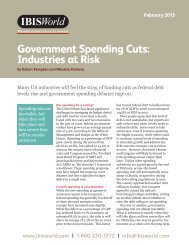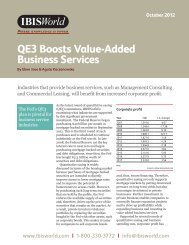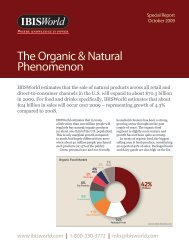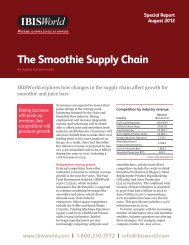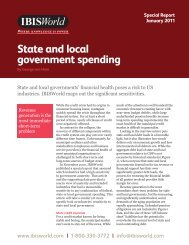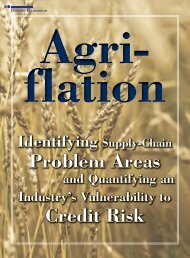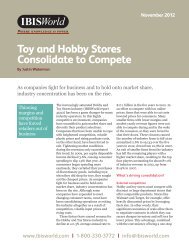Through the Cycle - IBISWorld
Through the Cycle - IBISWorld
Through the Cycle - IBISWorld
Create successful ePaper yourself
Turn your PDF publications into a flip-book with our unique Google optimized e-Paper software.
14<br />
Figure 2<br />
$2,000<br />
$1,900<br />
$1,800<br />
$1,700<br />
$1,600<br />
$1,500<br />
$1,400<br />
$1,300<br />
$1,200<br />
$1,100<br />
Figure 3<br />
15<br />
10<br />
5<br />
0<br />
-5<br />
-10<br />
-15<br />
Profits Rise Amid Weak Job Creation<br />
$1,000 2008 2009 2010 QI 2011 QII 2011<br />
underestimate <strong>the</strong> underemployed (8.8 million part-time<br />
workers seeking full-time work) and discouraged workers<br />
(those who have dropped out of <strong>the</strong> labor market, probably<br />
ano<strong>the</strong>r 6 or 7 million people).<br />
Unlike <strong>the</strong> fiscal stimulus provided by <strong>the</strong> American<br />
Recovery and Reinvestment Act of 2009 (ARRA), federal,<br />
state, and local governments are facing <strong>the</strong> prospects of<br />
unprecedented austerity as <strong>the</strong> debate to contain growth<br />
of public debt has taken center stage (Figure 3).<br />
President Obama’s recent job creation initiative is a step<br />
in <strong>the</strong> right direction, albeit a small one given <strong>the</strong> dearth<br />
of fiscal ammunition <strong>the</strong> administration needs to prime its<br />
governmental guns. To be sure, traction will clearly have<br />
to come from <strong>the</strong> private sector as U.S. policy makers have<br />
December 2011–January 2012 The RMA Journal<br />
Corp Profits (B)<br />
Unemploy (%)<br />
Sources: Bureau of Economic Analysis and Bureau of Labor Statistics<br />
Real Government Spending: Goodbye Stimulus?<br />
Seasonally Adjusted, Annualized<br />
Q1 2010 Q2 2010 Q3 2010 Q4 2010 Q1 2011 Q2 2011<br />
10<br />
Source: Bureau of Economic Analysis<br />
9<br />
8<br />
7<br />
6<br />
5<br />
Federal Defense<br />
Federal Nondefense<br />
State and Local<br />
yet to find <strong>the</strong> Holy Grail that will pull <strong>the</strong> U.S. out of <strong>the</strong><br />
malaise.<br />
Compounding jitters are problems brewing overseas,<br />
including China’s fight to control inflation and <strong>the</strong> European<br />
Union’s struggle to contain <strong>the</strong> region’s sovereign debt<br />
crisis.<br />
According to September’s National Association of Business<br />
Economists survey, GDP growth this year will be a<br />
paltry 1.7% and will <strong>the</strong>n accelerate slightly to 2.3% in<br />
2012. These forecasts are down 1% from <strong>the</strong> May survey.<br />
Unquestionably, <strong>the</strong> likelihood of a deleterious double-dip<br />
recession has increased.<br />
So… Where Do We Go from Here?<br />
An article in <strong>the</strong> December 2009-January 2010 RMA Journal 1<br />
offered some suggestions for finding solid C&I lending<br />
opportunities, which may be worth rereading since much<br />
of that analysis remains relevant. As underscored above,<br />
however, <strong>the</strong> economic landscape has changed dramatically<br />
and several of <strong>IBISWorld</strong>’s banking clients recommended<br />
that we revisit <strong>the</strong> topic.<br />
Obviously, this article can’t possibly delineate all of <strong>the</strong><br />
lending opportunities or risks. None<strong>the</strong>less, its aim is to<br />
provide some insights and, in particular, offer a methodology<br />
for seeking sensible opportunities. Our criteria will<br />
identify sectors that:<br />
• Are in <strong>the</strong> growth phase of <strong>the</strong>ir industry life cycle and<br />
are well positioned to take advantage of a sustained, if<br />
not spotty, economic rebound.<br />
• Do not present inordinate risks should a double-dip<br />
recession or shallow growth path result.<br />
• Are not excessively volatile.<br />
• Possess some attractive attributes regarding <strong>the</strong> level of<br />
competition and barriers to entry (based on <strong>the</strong> work of<br />
Anita McGahan and Michael Porter 2 ).<br />
• Are capital-intensive, implying a large borrowing<br />
capacity.<br />
• Can be potentially targeted as small business or midmarket<br />
clients.<br />
• Have strong growth potential over <strong>the</strong> next five years.<br />
Not an easy task indeed! But we believe we have a strong<br />
algorithm that takes advantage of <strong>the</strong> winds of change to<br />
clear <strong>the</strong> fog.<br />
What Can We Learn from History and <strong>the</strong> Recent <strong>Cycle</strong>?<br />
Although each cycle has its own unique characteristics, a<br />
long-term analysis of past economic recoveries reveals a<br />
concrete starting point.<br />
Using real value-added 3 data at <strong>the</strong> two-digit NAICS<br />
(North American Industry Classification System) level<br />
from <strong>the</strong> Bureau of Economic Analysis and <strong>the</strong> timing<br />
of recession troughs as defined by <strong>the</strong> National Bureau<br />
of Economic Research, <strong>IBISWorld</strong> examined <strong>the</strong> last 10



